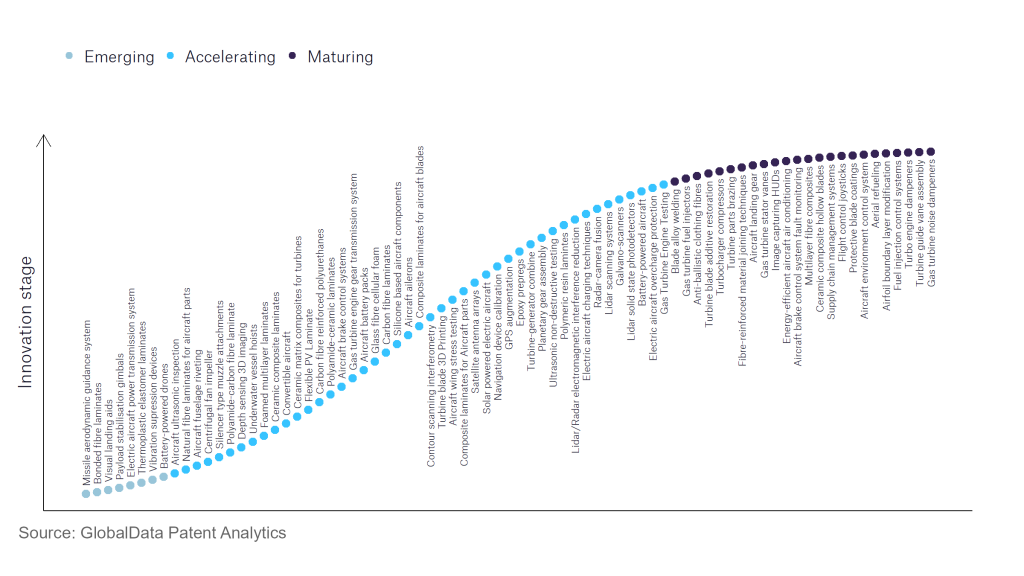The aerospace and defence industry continues to be a hotbed of innovation, with activity driven by the uptake of advanced technology, and growing importance of technologies such as hypersonics and advanced materials. In the last three years alone, there have been over 174,000 patents filed and granted in the aerospace and defence industry, according to GlobalData’s report on Innovation in Aerospace, Defence & Security: Turbine blade 3D Printing. Buy the report here.
However, not all innovations are equal and nor do they follow a constant upward trend. Instead, their evolution takes the form of an S-shaped curve that reflects their typical lifecycle from early emergence to accelerating adoption, before finally stabilising and reaching maturity.
Identifying where a particular innovation is on this journey, especially those that are in the emerging and accelerating stages, is essential for understanding their current level of adoption and the likely future trajectory and impact they will have.
180+ innovations will shape the aerospace and defence industry
According to GlobalData’s Technology Foresights, which plots the S-curve for the aerospace and defence industry using innovation intensity models built on over 262,000 patents, there are 180+ innovation areas that will shape the future of the industry.
Within the emerging innovation stage, bonded fibre laminates, thermoplastic elastomer laminates, and vibration supression devices are disruptive technologies that are in the early stages of application and should be tracked closely. Centrifugal fan impellers, ceramic composite laminates, and gas turbine engine testing are some of the accelerating innovation areas, where adoption has been steadily increasing. Among maturing innovation areas are protective blade coatings and blade alloy welding, which are now well established in the industry.
Innovation S-curve for the aerospace and defence industry

Turbine blade 3D printing is a key innovation area in aerospace and defence
3D printing is being gradually adopted across the aerospace and defence industries. It allows parts of various platforms to be made, repaired, or replaced in a most cost-effective, and often more sustainable way. Turbine blade is one such part, that is being 3D printed.
GlobalData’s analysis also uncovers the companies at the forefront of each innovation area and assesses the potential reach and impact of their patenting activity across different applications and geographies. According to GlobalData, there are 10+ companies, spanning technology vendors, established aerospace and defence companies, and up-and-coming start-ups engaged in the development and application of turbine blade 3D printing.
Key players in turbine blade 3D printing – a disruptive innovation in the aerospace and defence industry
‘Application diversity’ measures the number of different applications identified for each relevant patent and broadly splits companies into either ‘niche’ or ‘diversified’ innovators.
‘Geographic reach’ refers to the number of different countries each relevant patent is registered in and reflects the breadth of geographic application intended, ranging from ‘global’ to ‘local’.
Patent volumes related to turbine blade 3D printing
| Company | Total patents (2021 - 2023) | Premium intelligence on the world's largest companies |
| General Electric | 393 | Unlock Company Profile |
| Raytheon Technologies | 149 | Unlock Company Profile |
| Siemens | 142 | Unlock Company Profile |
| Safran | 96 | Unlock Company Profile |
| Rolls-Royce Holdings | 40 | Unlock Company Profile |
| Atlas Copco | 25 | Unlock Company Profile |
| Honeywell International | 20 | Unlock Company Profile |
| CDP Equity | 20 | Unlock Company Profile |
| Stryker | 20 | Unlock Company Profile |
| Howmet Aerospace | 19 | Unlock Company Profile |
| Mitsubishi Heavy Industries | 14 | Unlock Company Profile |
| SLM Solutions Group | 12 | Unlock Company Profile |
| Alstom | 10 | Unlock Company Profile |
| IHI | 6 | Unlock Company Profile |
| Porsche Automobil Holding | 5 | Unlock Company Profile |
| United Technologies International | 5 | Unlock Company Profile |
Source: GlobalData Patent Analytics
General Electric is one of the leading patent filers in turbine blade 3D Printing. In 2021, General Electric switched to 3D printing four parts for land/marine turbines. The company has cited lower production costs and faster time to market as the primary reasons for the switch in production method. Some other key patent filers in the area include Raytheon Technologies, Siemens, and Safran. Collins Aerospace, a subsidiary of Raytheon Technologies, has also begun to 3D print turbine blades.
In terms of geographic reach, Porsche Automobil leads the pack. Alstom and Atlas Copco stood in the second and third positions, respectively. By means of application diversity, SLM Solutions Group held the top position, followed by Howmet Aerospace, Porsche Automobil, Safran, and Alstom.
Turbine blade 3D Printing is likely to be further adopted by aerospace and defence companies as they seek to lower costs, and reduce their carbon footprint.
To further understand the key themes and technologies disrupting the aerospace and defence industry, access GlobalData’s latest thematic research report on Defence.
Data Insights
From

The gold standard of business intelligence.
Blending expert knowledge with cutting-edge technology, GlobalData’s unrivalled proprietary data will enable you to decode what’s happening in your market. You can make better informed decisions and gain a future-proof advantage over your competitors.



